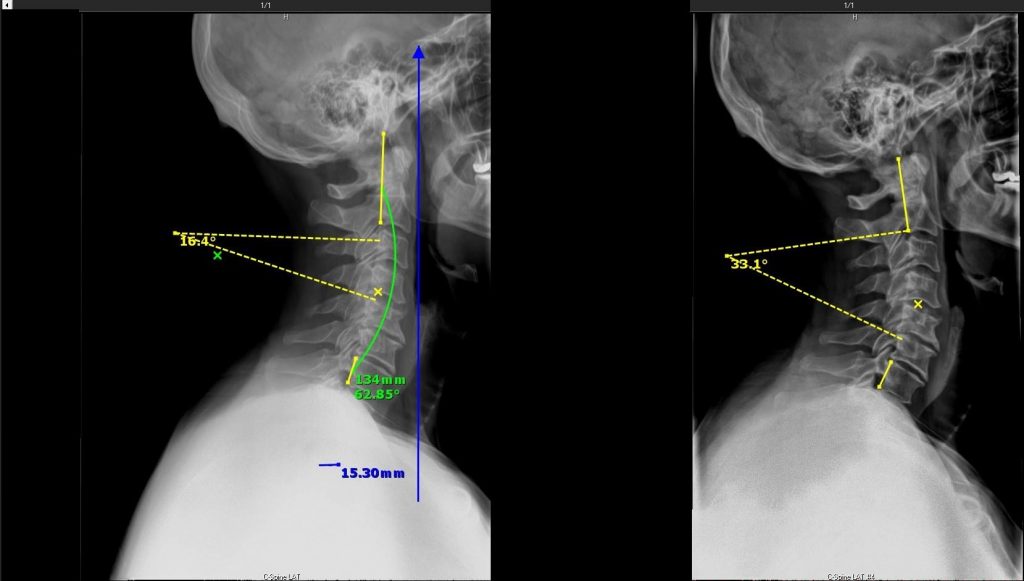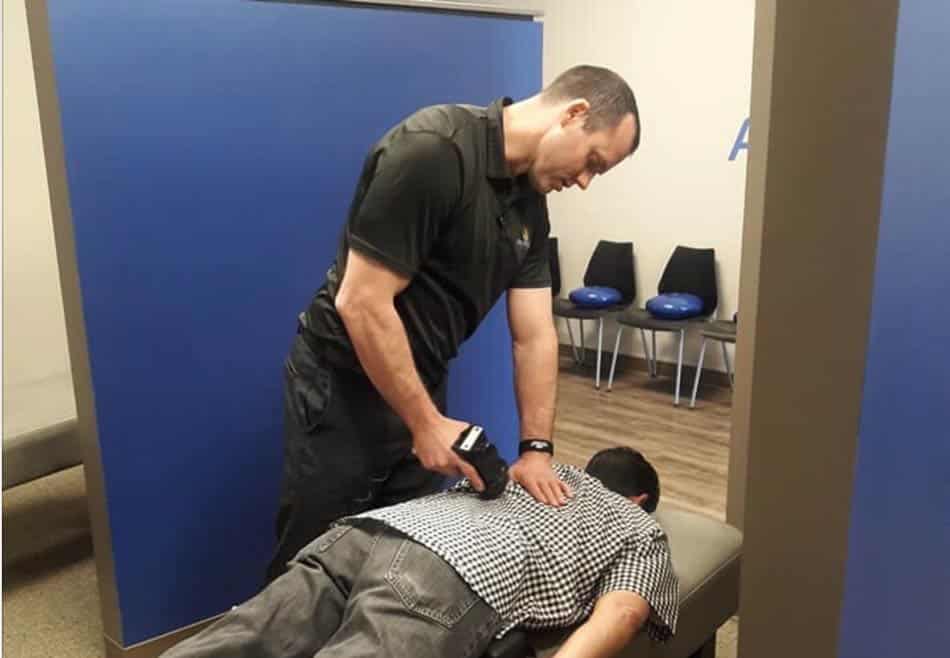Taking a Proactive Approach to Your Health!
Just as dentists take X-rays during check-ups to identify potential issues before they become symptomatic, chiropractors adopt a proactive approach to your health. In our chiropractic office, we utilize X-rays because they provide us with a comprehensive view of your spine, enabling us to identify problems before they escalate into major concerns. Here’s what we assess:
SPINAL ALIGNMENT
Front View: When examining frontal X-rays of the spine, we focus on assessing its alignment. A straight spine is better equipped to handle the daily stress and gravitational forces placed upon it. Conditions like scoliosis, characterized by lateral curves of 10° or more, indicate instability. Even minor deviations from a straight spine can lead to neurological interference.
Side View: In the side view, we ensure that your spine maintains the proper curves. The neck should exhibit a lordotic curve, sloping backward at approximately 34-45°, with the chin level. The thoracic region should display a kyphotic curve, sloping forward. These curves are essential for spinal stability, allowing your spine to adapt to the effects of gravity, body weight, and daily stressors, such as sitting and exercising.
THE ARC OF LIFE
In our practice, we consider the neck to be of utmost importance because it houses the beginning of the spinal cord. A healthy neck, with its 34-45° curve, is often referred to as the “Arc of Life.” This curve offers several benefits:
- Support for Head Weight: It provides more support for the weight of the head.
- Relaxed Spinal Cord: A curved neck allows the spinal cord to relax, facilitating better transmission of information between the brain and body.
- Reduced Forward Head Posture: It helps reduce forward head posture and mechanical pressure on the chest.
- Improved Spinal Biomechanics: Proper neck curvature contributes to the overall biomechanics of the spine.
Unfortunately, many people we see have lost the normal neck curve, often combined with an average of 30mm of forward head posture (anterior translation). This loss can lead to spinal cord tethering and neurological interference. The research underscores its significance:


- “Dr. Alf Alfred Breig, a neurosurgeon and Nobel Prize recipient, discovered that a loss of the cervical curve can stretch the spinal cord by 5 to 7 cm, leading to pathological tension and disease.”
- “Every inch of forward head posture can increase the weight of the head on the spine by an additional 10 pounds” (Kapandji, Physiology of The Joints, Vol. 3 – 35).
To illustrate the importance of neck curvature, we often conduct an experiment during our Dinner With the Doc Workshop. Participants attempt to take deep breaths with their chins jutted forward, finding it challenging. However, when they correct their posture by sitting up straight with their chin level and shoulders back, they can take deeper breaths with ease.
Forward head posture combined with a loss of neck curve places mechanical stress on the chest, reducing vital lung capacity by up to 30%. This leads to shortness of breath, stress, decreased energy, and sympathetic nervous system activation, which can result in elevated blood pressure, heart rate, blood sugar, decreased higher brain function, and increased muscular tension.
Improving spinal subluxation is crucial in maintaining a balanced autonomic nervous system and overall well-being.

IMPROVE YOUR POSTURE – YOUR POSTURE MATTERS
Your posture serves as a window into your spine’s health. Poor posture is not only a common cause of back pain but also triggers a perpetual state of “fight or flight” within your nervous system, leading to increased stress. It also accelerates joint wear and tear.
When evaluating posture, we consider the following:
Front View: We ensure that the head is straight, shoulders are level with the hips, and there is no rotation, contortion, or translation. The legs should be straight and not externally or internally rotated.
Side View: The head should align directly over the shoulders, with the shoulders pulled back and not rounded forward. The pelvis should maintain a neutral position, and the knees should remain unlocked.
In our practice, we prioritize correcting posture through Chiropractic Care, Physiotherapy, and Proper Rehab Exercises. Notably, as patients’ posture improves, the effects of Chiropractic Adjustments tend to last longer. Therefore, a focus on posture correction should be an integral part of your Chiropractic Care Plan!


The Impact of Posture: Good vs. Bad
Maintaining proper posture is more than just a matter of aesthetics; it directly influences your physical health and well-being. Here’s a look at how good posture benefits you and the detrimental effects of poor posture:
Benefits of Good Posture:
- Lower Back Health: Good posture is your lower back’s best friend. It helps distribute the weight evenly across the spine, reducing the risk of lower back pain.
- Neck Pain Prevention: Proper posture ensures that your neck is in alignment with your spine, reducing the likelihood of neck pain and discomfort.
- Abdominal Engagement: Maintaining good posture requires engaging your abdominal muscles, which can help strengthen your core over time.
- Improved Lung Function: Good posture allows your lungs and intestines to work efficiently, enhancing your breathing capacity and digestive processes.
- Optimal Body Alignment: When you have good posture, your body alignment is correct, preventing muscle fatigue and stiffness throughout your body.
- Better Standing Posture: Practicing good standing posture can alleviate tension in the upper back and shoulders, helping you feel more comfortable and relaxed.
- Enhanced Body Awareness: Good posture cultivates body awareness, making you more mindful of your body position during everyday activities.
Effects of Bad Posture:
- Lower Back Pain: Slouching and poor posture can lead to chronic lower back pain, which is a common issue for those who sit for many hours.
- Neck Strain: Hunching and craning the neck while working on a computer or phone can result in neck strain and discomfort.
- Upper Limb Problems: Bad posture can cause issues in the upper limbs, including rounded shoulders and a forward head position.
- Digestive and Breathing Issues: Poor posture can affect the functioning of your lungs and intestines, making it harder for them to work optimally.
- Muscle Fatigue: Maintaining an incorrect body position over time can lead to muscle fatigue and discomfort.
- Posture-Related Headaches: Poor posture can contribute to tension headaches, as the muscles in the neck and upper back can become strained.
- Spinal Misalignment: Continuous bad posture may lead to spinal misalignment, which can cause more serious health problems over time.
Ways to Improve Your Posture:
- Sit and Stand Properly: Whether you’re sitting or standing, aim to maintain proper posture with your spine aligned.
- Use Ergonomic Support: When working from home or at a desk, use ergonomic furniture and accessories to support good posture.
- Stay Active: Incorporate exercises that strengthen your abdominal and back muscles to help improve posture.
- Regularly Adjust Position: Be mindful of your body position during everyday activities and make adjustments as needed.
- Take Breaks: If you spend a lot of time sitting, take breaks to stretch and move around to prevent stiffness.
- Body Awareness: Develop body awareness to recognize and correct rounded shoulders or slouching.
- National Institutes of Health Guidelines: Follow guidelines from the National Institutes of Health to improve your posture and reduce the impact of prolonged sitting.
Tips and Exercises to Better Your Posture
Posture problems can affect people of all ages and lifestyles, but the good news is that there are effective ways to correct and maintain better posture. Here are some tips and exercises to help you on your journey to improved posture:
1. Feet Flat on the Floor: When sitting, ensure both feet are flat on the floor, hip-width apart. This provides a stable base and promotes good posture.
2. Sit at a Right Angle: When sitting in a chair, aim for a right-angle bend at your hips and knees. Avoid crossing your legs, as it can lead to poor posture over time.
3. Use a Pillow: If your chair lacks lower back support, place a pillow or cushion behind your lower back to help maintain the natural curve of your spine.
4. Body Awareness: Be conscious of your body position during everyday activities. Regularly remind yourself to hold your body in a neutral and aligned position.
5. Exercises to Improve Posture: Incorporate exercises into your routine that target the muscles responsible for maintaining good posture. Focus on strengthening your core, back, and neck muscles.
6. Posture Exercises: Certain exercises, such as planks, bridges, and wall angels, can help improve posture by strengthening the muscles that support your spine.
7. Posture While Sitting: When working at a desk or computer, ensure your monitor is at eye level, and your keyboard and mouse are within easy reach. Adjust your chair height to maintain proper posture.
8. Take Breaks: Avoid sitting for extended periods. Take short breaks to stand up, stretch, and move around. This can help prevent stiffness and posture problems.
9. Avoid Sitting for Many Hours: If your work requires long hours of sitting, consider investing in a standing desk. Alternating between sitting and standing is a great way to prevent posture problems.
10. Posture While Sleeping: Pay attention to your sleeping posture. Use a comfortable mattress and pillows that provide proper neck and spine support.
11. Posture Refers to All Positions: Remember that good posture is important whether you are sitting, standing, or lying down. Maintain the alignment of your spine in all positions.
12. Posture Over Time: Understand that improving your posture is a gradual process. Consistency is key, and over time, you will notice positive changes in your posture.
13. Neck Exercises: Incorporate exercises that help strengthen your neck muscles, as a strong neck can better support your head in the correct position.
14. Body Alignment: Focus on aligning your body correctly with a straight spine and relaxed shoulders during daily activities.
15. Posture at Work: If you have a desk job, consider ergonomic adjustments to your workspace. Ensure your chair, keyboard, and monitor are positioned to promote healthy posture.
16. Posture Awareness: Cultivate a habit of regularly checking and correcting your posture. Utilize mirrors or seek feedback from others to ensure you’re holding your body correctly.
By following these tips and integrating posture exercises into your routine, you can gradually help correct rounded shoulders, improve your posture, and reduce the negative effects of poor posture on your back and neck.
For more information, please refer to this video.



